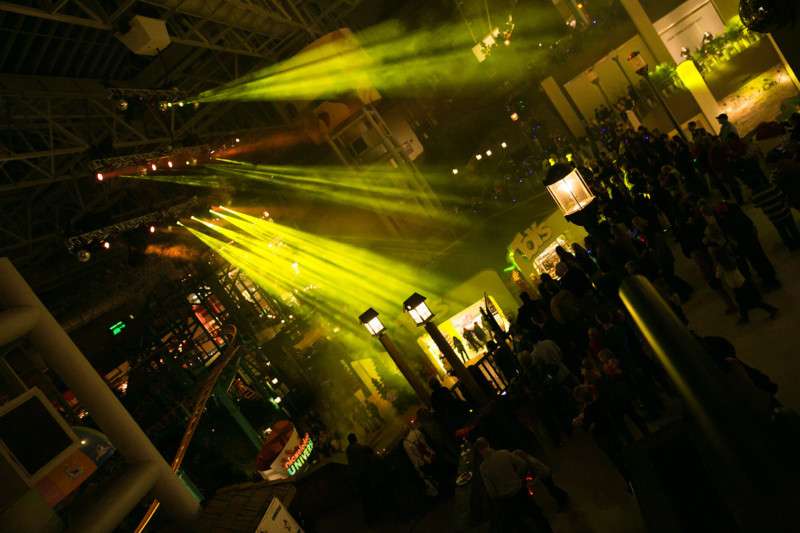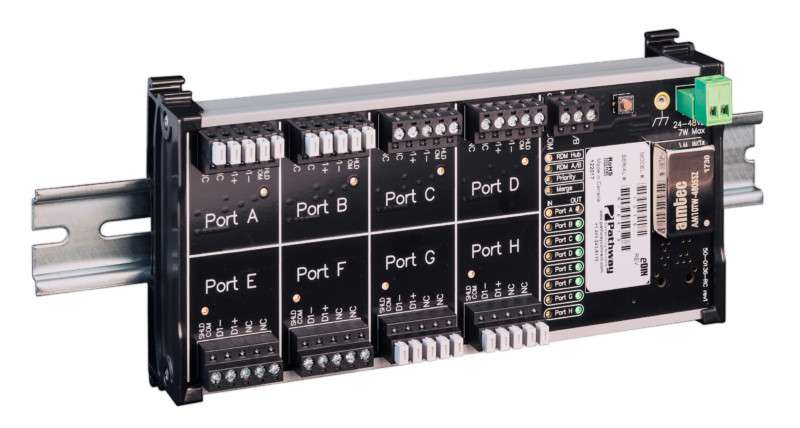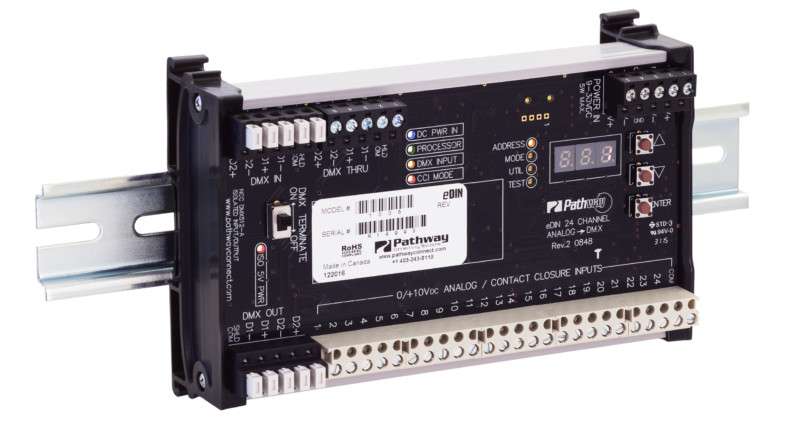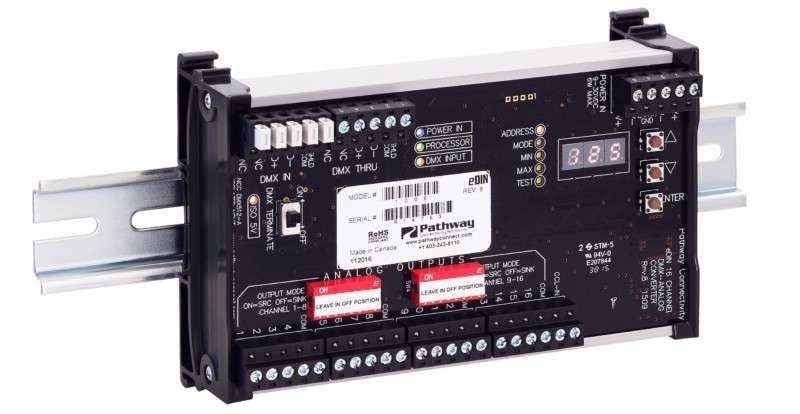By David Paul Green
Because DMX was created to allow equipment from different manufacturers to communicate, this foundation of collaborative control has allowed it to expand beyond lighting.
This article is part of the InPark “widget masters” series, focusing on technical equipment and software, its manufacture, design, applications for themed entertainment, and the specialists making it happen.
Top photo: The “Universe of Light” show at Nickelodeon Universe at Mall of America. The lighting systems are all controlled and scheduled by a Medialon show control system (Barco). Photo Credit: Jayson Raitt / Quantum Creative Studios.
The origins of Digital Multiplex 512
In 1986, shortly before the start of public use of the Internet, lighting designers realized they needed a standardized method to control stage lighting and effects. The US Institute for Theatre Technology (USITT) helped foster such a system, with the catchy name, “Digital Multiplex 512,” abbreviated DMX512. The technology got its name because it allows the user to squeeze or multiplex up to 512 control signals down one wire, controlling them digitally, via equipment such as a lighting control board. Each set of 512 control channels (or more correctly, data slots) is called a “universe.”
Now an ANSI standard, known widely today simply as “DMX,” the protocol has grown beyond stage lighting and effects, to handle other aspects of show control. This is good news for the designers of today’s media-rich, technology-rich visitor attractions that often incorporate interactivity and strive to be ever more immersive.
Because DMX was created to allow equipment from different manufacturers to communicate, this foundation of collaborative control has allowed it to expand beyond lighting. DMX’s standardization, robustness, and relative ease of implementation have made it nearly ubiquitous, not just in stage environments, but in themed entertainment and architecture as well.
Bringing harmony to chaos

Eric Cantrell, Sales Manager for A/V Control Experience and Show Control at Barco, says, “As new tech such as moving lights was invented, each manufacturer had its own protocol. It was a big mess. DMX came out to harmonize and increase interoperability with consoles, and moving lights, as well as dimmers.”
Eventually, Cantrell says, DMX controllers could “control other things that are maybe lighting-adjacent, such as video.” DMX grew in popularity, he adds, because, “It was a standard protocol that lighting techs already knew how to use,” which meant additional technical personnel weren’t needed for projects that already had lighting programming expertise on site.

Scott Arnold, CEO of AV and technical design company Tech Fulcrum, says, “Certainly, designing a theater is completely different than it used to be. Round one of DMX was putting shielded cable suitable for carrying a serial signal from your booth to your dimmer room, and that was it.” Now, he says, “the ability to push this over inexpensive Category 5e or 6 cable – whether through replicating DMX over Ethernet, or converting it, using devices – now you can set up a big Ethernet network through your theater, using off-the-shelf network components that are much less [expensive] than lighting-specific components.”
Arnold adds, “From an infrastructure standpoint, that evolution has been exceptionally useful. Also, there is the wireless standpoint. Being able to go wireless opens up possibilities for parade floats, costumes, or trusses that can be loaded in and struck very quickly.
From lighting to coffee pots, to…
“As far as what people are using it for,” Arnold adds, “there are obvious things beside lighting, like pixel-mapping…. Doug Fleenor has got a coffee pot!”

Indeed, Milton Davis, Engineer at Doug Fleenor Design, lists several other “gag” products the company has created over the years, as fun ways to showcase DMX’s flexibility: they include a DMX-controlled glockenspiel, Etch-A-Sketch, shock collar, ice bucket challenge, and beer keg.
“They are always things that are technically possible, but functionally questionable,” Davis jokes; however, “they all have grown out of some real-world application of one sort or another.”
Which sort of begs the question: Why? (And how?)
“We make DMX controlled relays,” Davis says. “It isn’t odd to think of a relay as a DMX-controlled widget. Well, what happens if you put the relay in a coffee pot? Now you’ve got a DMX coffee pot. Anything you can plug into a relay becomes a unique and interesting DMX application.”
On a more practical basis, Davis says, real projects the company has worked on include DMX-controlled “hazers, foggers, gobo rotators, fiber optic illuminators, window shutters, projection screens, LCD walls that can go opaque or clear, video switches, video projectors, DVD machines; elevators where, when you … push a button, certain lighting effects take place as you move up and down.” They’ve also developed small stage lifts for non-human loads, and a system for monitoring theme park rides, “sort of a heartbeat indicator,” Davis says.
Other projects, Davis says, include, “In New York, the Times Square ball – we have distribution inside the video ball they are using for that. Electroluminescent lighting on costumes, under DMX control. We’ve been involved with Blue Man Group doing DMX-controlled, highly synchronized strobe lights.”
Indeed, as the technology has evolved, the imagined uses for it continually exceed its inventors’ intentions. “It’s a far call from controlling 24 dimmers in a closet,” Arnold says, “to pixel-mapping trees across a lake.”
DMX in the Networking Era

Bryan Palmer, Architectural Market Manager at ETC, concurs. When the standard was developed, he says, it supported, “512 control addresses on a single wire, and in 1990 that was a lot. In a system today, we’re talking about thousands, tens of thousands, and sometimes hundreds of thousands of control addresses.”
Because DMX was not designed to handle that many addresses, new, compatible protocols have been developed to provide needed functionality, such as enabling the transmission of DMX data over an Ethernet network: “There are Ethernet-based versions of DMX,” Palmer says, “which include Streaming ACN and Art-Net as the two primary versions, that work just like DMX does, but you can do millions of control addresses over a single Ethernet cable.”
Cantrell adds, “Now, we have devices that have an Ethernet jack on them, that are being programmed via DMX.”
“Two gentlemen involved in the creation of the DMX protocol were Steve Terry and Adam Bennett,” Palmer notes, “and they both work with us [ETC] now.” That expertise, he says, allows ETC to excel in the manufacture of products for DMX applications.
Palmer adds, “As the technology we’re using is advancing more and more, we are going to see a shift to the Ethernet versions of DMX. People want systems that can be interconnected. The simplest way to do that is get them all on the same network.”

Robert Bell, Director of Product Innovation at Pathway Connectivity, notes that despite the ability to connect DMX devices via Ethernet, “The final mile is going to be DMX for a long time.
“By routing it over Ethernet,” he continues, “you break the 512 boundary. [However] the final jump is going to be that DMX512 layer. That’s just because it’s so useful to daisy chain a controller out to multiple devices. The processing power to receive DMX is just a tiny micro. You don’t have to have an Ethernet stack behind it.”
PHOTOS COURTESY PATHWAY CONNECTIVITY SOLUTIONS:
Bell sees a lot of fountains being controlled by DMX. “We have a number of interface cards,” he says. “One that is quite popular is a relay card. People use it to control small motors, and valves. A lot of fountain design companies are now using DMX control systems. They are just treating them like luminaires. You don’t need to have high-powered processors in the end devices, and it is very robust for spread-out areas.”
Another unexpected area where Bell sees DMX being used is in architectural installations, controlling 0-to-10 volt lighting. “One of our most popular interfaces is our DMX512 to 0-10V interface card,” Bell says, confessing, “Which is just crazy, you have a digital light source and you’re using an analog control signal.”
DMX and media

Graham Whipple, product specialist for Green Hippo, says the company creates products that allow DMX to integrate with media control. “The way I see DMX as the most helpful in media, is it allows a bridge for people with a lighting background to move into video,” Whipple says. “You don’t have to know how to use a video switcher to be able switch inputs on a media server, if you have a background in lighting. You can control that from the lighting desk.
“With Hippotizer Media Servers, we allow you to control anything through DMX,” Whipple continues. “It’s really broad and a little bit difficult to discuss exactly how it works, because it’s so flexible. One way is to cue things up on the media server – you can even create a timeline of several different cues – and give ‘go’ or ‘stop’ commands via DMX.
“The other way you can do it is to give a lighting console control of every parameter,” Whipple continues, “and program your entire media show as if your server was one big moving light.”
SLIDESHOW PHOTOS COURTESY GREEN HIPPO:
This is particularly useful when it comes to huge implementations of LEDs, or LED screens. “If you have an installation with something like 85,000 RGB LEDs, that’s going to be 500 universes,” Whipple says. “It becomes a nightmare to try to program that. So a shortcut is using the video content to play across that. The lighting console is controlling a media server as a way to output DMX to control all of these lights, without having to program them individually, which would be nearly impossible. That’s probably one of the bigger advantages in a purely lighting installation, to use a media server.”
Whipple concludes, “With a forest of LEDs, or a floor of LEDs, programming them individually just isn’t feasible. You’re going to get a better artistic product by figuring out what you want to do as a whole, and using media to accomplish that.”
Bad DMX Ideas
We see that DMX has potential benefits in many applications. However, life-safety systems are not one of them.
“I do have an issue with trying to use DMX – especially one-way DMX – for things that are safety related,” says Scott Arnold. ”Show action equipment, flame, CO2 releases. If there is no feedback, you run the risk of having an unintended consequence. The only way I would consider having it in the safety chain, is to have E-stops, dead-man switches.”
Eric Cantrell agrees no one should be “running chain motors and things off of DMX. When you have heavy things moving around, I don’t like seeing the possibility of hitting a blackout button and everything crashing to the ground.”
Bryan Palmer also concurs. “Anytime you are moving things, or interacting with equipment that could physically harm somebody, DMX is a less-appropriate choice, because it allows for control from a remote location, and that’s not a good safety situation.”
Milton Davis adds, “DMX is not for pyrotechnics or safety-related things, ever. There’s no error checking whatsoever. Basically, you blow a lot of data out, and hope to God it gets there.”
That lack of error checking is why Robert Bell calls DMX a “barking protocol,” adding, “I just stop short of telling people to use DMX for rigging control.”
Palmer sees the issue as a larger one, tied to the Internet of Things that is being adapted into our daily lives: “As we move into this world of IoT mindset where everybody wants everything interconnected, I think this is going to be a topic where people are going to start having a lot of conversations. I think we’re going to see some regulatory and safety standards get written about how it needs to work with local safety switches to resolve those kinds of concerns. It is definitely a topic that warrants some thought and consideration.”
Palmer adds that “the flip side to that is when we start talking about lighting specifically, like emergency lighting situations, there are still applications where DMX is an appropriate choice and you don’t have a lot of other options. If I want to have a color-changing fixture, and that fixture needs to be a part of the emergency system, my real only choice is to send it DMX, and there are products that are built specifically for those applications, in that when an emergency situation happens, it goes into white light, and does exactly what it’s supposed to do to keep people safe and allow for egress from the building.”
What’s Next?
If by now you’re thinking that DMX can do just about anything, you might be right.
Milton Davis says, “Our role is to take something that we’ve got, and start applying that to a different world. DMX has expanded and just gotten a lot bigger over the years.”
DMX Tech Talk
Each set of 512 data slots in a DMX network is called a “universe.” Each universe connects to a master controller, which can control up to 512 slots. A simple, lighting dimmer may use just one slot. An RGB LED fixture might use three slots. Other types of devices may use even more. If you need to accommodate more than 512 data slots, then you need to add an additional universe.
Why is DMX512, 512? Milton Davis, of Doug Fleenor Design, says, “When it was created, 512 items was so big, you would NEVER have anything that big. Never. Of course things change. It all actually still makes sense. 90% of the real-world applications out there – schools, churches, etc. – still fit within one universe of DMX.”
Modern DMX controllers can control multiple universes from a single device. A standard DMX connector is a five-pin connector, with female connectors used on transmitting (OUT) ports, and male connectors used on receiving (IN) ports.
To connect DMX devices, you need to use a specialized 5-pin cable to go from the controller, to the first device’s IN port. Then that same device’s OUT port is cabled to the next device’s IN port, and so on. This method of connecting devices is referred to as a “daisy chain,” after the garlands of flowers made by children in bygone times. Because DMX is a specialized system, the various cables and connectors can be relatively expensive – especially when large distances are concerned – as compared to less-specialized networks, such as Ethernet.
 David Paul Green is president and COO of Los Angeles-based lighting design firm Visual Terrain, as well as a writer and photographer. After starting off in themed entertainment at WED Enterprises (now WDI), working on EPCOT, Disneyland, and Tokyo Disneyland, David went on to work with other divisions of The Walt Disney Company. As principal at consulting firm Monteverdi Creative, David holds eight U.S. Patents for innovations in digital TV user interface design. In 2010, David joined his wife, Lisa Passamonte Green, at Visual Terrain. He is the co-author of “Building a Better Mouse” with Steve Alcorn, and has written for InPark, Lighting&Sound America, and others. His photography is in the permanent collection of the California African American Museum, and is featured in the catalog for the exhibit, “Allensworth: A Place. A People. A Story.”
David Paul Green is president and COO of Los Angeles-based lighting design firm Visual Terrain, as well as a writer and photographer. After starting off in themed entertainment at WED Enterprises (now WDI), working on EPCOT, Disneyland, and Tokyo Disneyland, David went on to work with other divisions of The Walt Disney Company. As principal at consulting firm Monteverdi Creative, David holds eight U.S. Patents for innovations in digital TV user interface design. In 2010, David joined his wife, Lisa Passamonte Green, at Visual Terrain. He is the co-author of “Building a Better Mouse” with Steve Alcorn, and has written for InPark, Lighting&Sound America, and others. His photography is in the permanent collection of the California African American Museum, and is featured in the catalog for the exhibit, “Allensworth: A Place. A People. A Story.”
David Paul Green photo credit: Josh Premako: www.joshpremako.com










